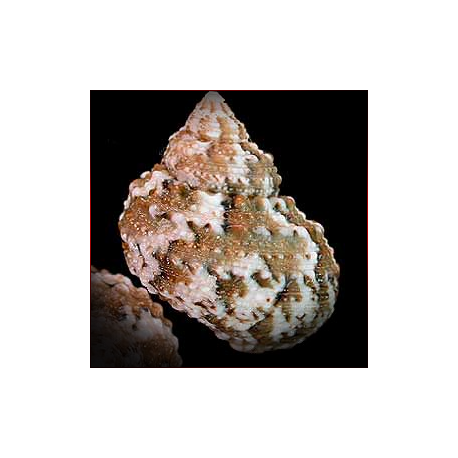More info
Datasheet
| Maximum Size | 5.1cm / 2.01inches |
| Reef Compatible | Yes |
| Temperament | Peaceful |
| Care Description | Easy |
| Specific Gravity | 1.023-1.025 |
| Carbonate Hardness | 8-12 |
| pH | 8.1-8.4 |
General Description
The Chestnut Turbo Snail (Turbo castanae) is a charming addition to any reef aquarium, sporting a top-shaped shell adorned with well-defined spirals and soft brown hues accented with reddish-brown to cream patches. Known for their diligent algae-cleaning capabilities, these snails are peaceful housekeepers both in the wild and in home aquariums.
Aquarium Suitability
With an easy care level, Chestnut Turbo Snails are ideal for both novice and experienced reef hobbyists. They thrive in environments with ample hiding spots, room to graze among live rock, and a reasonable algae growth for their diet.
Demands, Care, and Hardiness
Featuring a peaceful temperament, these herbivorous snails require dried seaweed as a dietary supplement, especially if natural food sources are scarce. Maintaining proper calcium levels is crucial for shell development, while keeping low nitrate levels and avoiding copper-based medications are essential due to their sensitivity.
Reef Suitability
Reef-compatible, the Chestnut Turbo Snail is a valuable addition to reef ecosystems, contributing to algae control and adding visual interest with its unique coloration and shell structure.
Aquarium Setup
In an aquarium, provide Chestnut Turbo Snails with hiding places, live rock for grazing, and a suitable algae growth for natural feeding. Ensure water conditions are within the parameters of pH 8.1-8.4, dKH 8-12, and salinity of 1.023-1.025.
Behaviour
These snails exhibit peaceful behavior in aquarium settings, diligently cleaning algae from surfaces while moving gracefully throughout the tank.
Feeding and Diet
Primarily herbivores, Chestnut Turbo Snails consume algae and benefit from supplemental dried seaweed for optimal nutrition in the absence of natural food sources.
Dimorphism
Chestnut Turbo Snails do not display distinct dimorphic characteristics, making differentiation between mates challenging, especially considering their minimal breeding success in aquarium settings.
Habitat and Distribution
In the wild, Chestnut Turbo Snails are commonly found in crevices and holes within reefs, serving as effective algae cleaners. Their distribution ranges among reef environments where they contribute to maintaining ecological balance.

